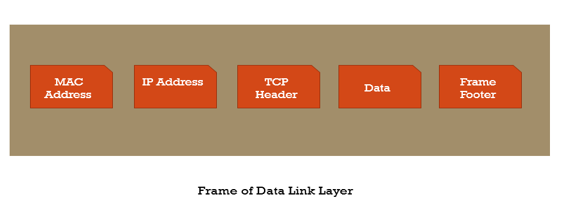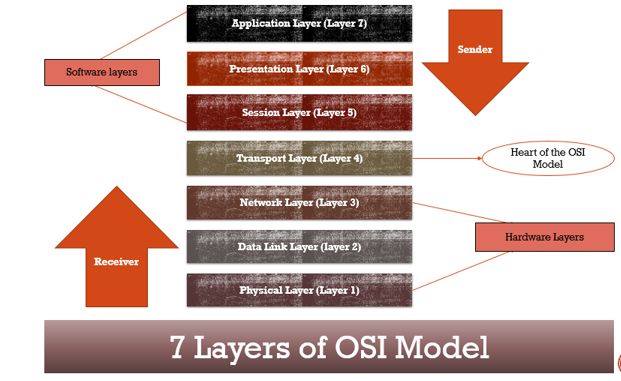OSI Layers – Open System Interconnection Model is a framework that describes the characteristics and communications functions of telecommunication or computing systems. OSI model became popular around the 1980s and was adopted by computer and telecommunication companies.
OSI model is still used to understand the TCP/IP concept, this concept of 7 layers model was provided by Charles Bachman at Honeywell Information system. OSI model is widely used around the globe which contains 7 layers and explains the data transfer from Source “A” to destination “B” around the internet.
Seven Layers of OSI Model
Physical Layer (Layer 1)
It is the lowest layer in the OSI model, this layer is responsible for physical connections between the devices. It is also called as Layer 1 OSI model which transmits the data in bits i.e., 0s and 1s. The physical layer will receive the signals in various formats like digital, electrical, radio signals and convert them to bits (0, 1) and send them next layer called the Data Link layer.

Functions of Physical layer,
- Bit-by-bit or Symbol-by-Symbol delivery
- Line Coding.
- Bit synchronization.
- Start-stop signal.
- Circuit switching.
Physical Layer Examples :
Technology supports Physical layers are,
- 802.11 wifi,
- PCI express Physical layer in Computer motherboards,
- USB Physical layer,
- Telephone network Modems,
- RJ45 network cable
- Bluetooth
- HUB, Repeater devices.
Data Link Layer (Layer 2)
The second layer or Layer2 of the OSI model is a protocol responsible for data transfer from Node A to Node B in WAN (Wide Area Network)/LAN (Local Area Network) segments. The main function of this layer is to transfer data between the networks which detects and corrects an error that may occur in the Physical layer.
When DLL receives the data packet, it transfers to the Host using the MAC address of the destination host. The Units of DLL are called frames, where the received packets are divided into frames.

Functions of DLL,
- Data Encapsulation – is where once the packet is received from one layer it is then placed in the data portion of the frames.
- Frame Synchronization– Used for decoding or retransmission of the received packets in the frame.
- Logical Link Controller (Error & flow Control) – Error control detects the damaged packets and flows control checks for the amount of data acknowledgment sent/received packets.
- Media Access Control (MAC) – Used for a network address communication within a network segment (LAN/WAN).
Example of Data Link Layer (DLL),
- Ethernet
- Wi-Fi (IEEE 802.11, IEEE 802.2)
- Bluetooth, ATM (Asynchronous Transfer Mode)
- Frame relay, etc.
Network Layer (Layer 3)
This layer is responsible for packet forwarding to the intended destination based upon the address contained in the frame received from DLL. Network Layer finds the destination using logical addressing called IP (Internet Protocol) addressing. The IP address of the sender and receiver is placed to route the packets. Packets are referred to as Segments in the Network layer.
Functions of the Network layer,
- Connection Model.
- Host addressing – which contains the IP address of sender and receiver.
- Message forwarding – Routing the packets as per the protocol.
Examples of Network Layer
- ICMP – Internet Control Message Protocol.
- IPv4/IPV6 – Internet Protocol.
- OSPF, RIP – Routing protocol models.
- IPsec – Internet Protocol Security.
Transport Layer (Layer 4)
This is the layer where you’ll find one of the popular networking protocols called TCP (Transmission Control Protocol) and UDP (User Datagram Protocol) which is responsible for end-to-end packet delivery. The transport layer communicates with the Application layer by making system calls through protocols and this layer 4 is operated by the Operating system level, also this layer is called as Heart of the OSI Model.
TCP also ensures that it receives the acknowledgment from the source and destination packets to rectify the correct packets sent and received in Sequential format without any errors in packet counts & data size. TCP is used for Connection-Oriented Protocol, whereas the connectionless User Datagram Protocol (UDP) is used for simple messaging transformation differs from TCP functionalities.

Functions of Transport Layer,
- Connection-Oriented Communication.
- Sequential Order of Packet delivery.
- Reliability (Error and Data Size).
- Flow Control.
Example Transport Layer :
TCP, UDP, TLS, SSL, RDP, etc,
Session Layer (Layer 5)
Session Layer is responsible for opening, closing, and managing the sessions between the different computer nodes ie, a session between Comp A to Comp B. For transmitting the data over the network there must be a session established and this layer makes sure that the sessions are properly established and maintained.
Session layers are commonly used in application environments that make use of Remote Procedure Call (RPC) which includes authentication and reconnection services.
Functions of session layer,
Authentication, Reconnection, Session restoration.
Example of Session Layer,
NetBIOS, RPC, SCP, SOCKS, SQL etc,
Presentation Layer (Layer 6)
In this layer data is translated or formats from one type of representation (Syntax) into another (Syntax) over the network, this layer is where the data encryption, decryption process takes place which is required by the Application Layer. The presentation layer converts the data over the network into a form that the application layer can be accepted. This is also called as Translation layer or Syntax layer.
The function of layer 6,
- Encryption and Decryption
- Data Conversion
- Character code translation (ASCII to EBCDIC).
For example of Layer 6 :
ASCII, GIF, JPEG, MPEG, HTML, DOC, MP3, etc,
Application Layer (Layer 7)
The highest level of the OSI model is closest to the user, which means the user and application layer directly interact with each other and deals with the software applications to communicate over the network. A commonly used application layer is HTTP (Hypertext Transfer Protocol ) which is used in Web browsers like Chrome, IE, Firefox, etc.,
The function of the Application layer,
- Network Virtual
- Mail Services
- Directory services etc,.
For Example of layer 7 :
- FTP (File Transfer Protocol)
- SMTP (Simple Mail Transfer Protocol)
- DNS (Domain Name System)
- Bit Torrent, Bitcoin
- LDAP (Lightweight Directory Access Protocol)
- NTP (Network Transfer Protocol), etc.
